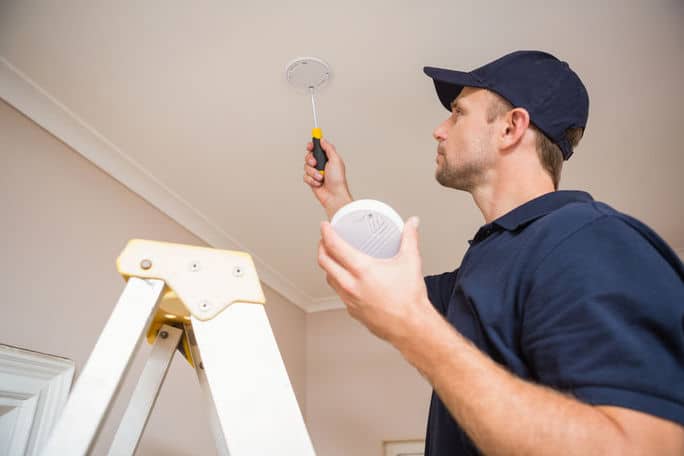How to Stop a Fire Before It Starts

Following these tips from the American Red Cross Bay Area can help save your life.
Smoke & Carbon Monoxide Detectors Are Essential.
From 2012-2016, fire departments across the U.S. responded to an average of 355,400 home structure fires per year. These fires were responsible for 2,560 civilian fire deaths, 11,670 civilian fire injuries and $6.5 billion in direct damage. 1Additionally, 80% of all fire deaths and 74% of all fire injuries were caused by home fires.
A fire can occur at any time. That’s why every bedroom in your home, condo or apartment, should have a working smoke and carbon monoxide detector. Carbon monoxide (CO) is a tasteless and odorless gas. There is no substitute for having a working CO detector. The average cost of a combined CO / smoke detector is about $20 to $30, which is a very small price to pay for the ongoing security and safety of you and your family.
In addition, you should test smoke detectors regularly and change their batteries twice a year. To make this easier to remember, change them in the spring and the fall when you change your clocks for Daylight Savings Time.
Have Fire Extinguishers at The Ready Throughout Your Home.
Fire extinguishers are inexpensive –– as low as $15 to $20 per unit. Extinguishers are available at hardware stores and large chains like Home Depot nationwide.2
You just never know when a fire will break out in your home. It is important to have a few fire extinguishers in several places –– upstairs and downstairs. Not only is it important to scatter a few around the home, but having a few in the kitchen is a good idea.
Additionally, teaching yourself and your kids how to use the fire extinguisher is an important first step. Set aside the time now to do this with your family.
Steps to Minimize a Fire’s impact on Your Home and Family:
- Call PG&E if you see any hanging wires or trees close to the power lines near your home.
- Ensure that your renters’ or owners’ insurance policy has protection against fires and resulting fire damage.
- Install smoke detectors in each room of your home, especially bedrooms and the kitchen.
- Place and practice alternative evacuation routes, especially from second story bedrooms.
- Install safety release latches on window security bars.
- Make sure all windows can open and are not painted shut
- If you rent, check with your landlord to make sure that electrical outlets are designed to handle appliance loads.
- Keep all flammable items away from wall and floor heaters.
- Exercise care when using candles and space heaters.
- Store all flammable liquids in airtight containers and away from ignition sources such as stove and water heater pilot lights.
- Mount a fire extinguisher in the kitchen for grease fires, from sparks from faulty wiring, and other possible causes of fire.
Are You Teaching Your Kids to be Firefighters?
It’s never too early to have your kids follow these tips to ensure their safety in a fire:
- Show your children where your home’s fire extinguishers are––and how to use them. You should have at least one extinguisher per floor of your house.
- Teach your kids not to play with matches; tell them to stay away from hazards like your fireplace or barbeque.
- Make sure everyone in your family knows their emergency exit drill and evacuation routes. There should be multiple exit routes.
- Have your kids keep furniture and flammable items, from towels and papers, away from wall and floor heaters.
- Attach child safety plugs to all electrical outlets.
- Teach your children how to use the 9-1-1 phone system and rehearse what to say to the 911 operator.
- Make sure all of your family members are ready to protect themselves if their clothes catch fire with STOP, DROP AND ROLL.
Did Your Roof Just Catch Fire? You Have Three Minutes to Evacuate. Now What?
You never think it will happen but if a fire breaks out in your home, following these steps may make the exit quick and safe:
- Prepare a Go-Bag of important documents, mementos and medications in a fireproof safe or portable bag. Things to include are: medications, a change of clothes, insurance and mortgage information, list of credit cards, passports, financial records, family photos, wills and medical records.
- Designate an emergency meeting place outside of your home for all members of your family, this can be a nearby family member’s home or safe area.
- On a regular basis, practice emergency exit drills.
- Have a contingency plan for family members to contact each other.
- Take First Aid and CPR Training, maintain first aid supplies to treat the injured until help can arrive.
1https://www.nfpa.org/News-and-Research/Data-research-and-tools/Building-and-Life-Safety/Home-Structure-Fires
2https://home.costhelper.com/fire-extinguishers.html
Contact information:
Al Stoll is available at 415.762.0039 and astoll@stoll-law.com
Jessica Juarez is available at 415.418.2459 and jessica@stoll-law.com
